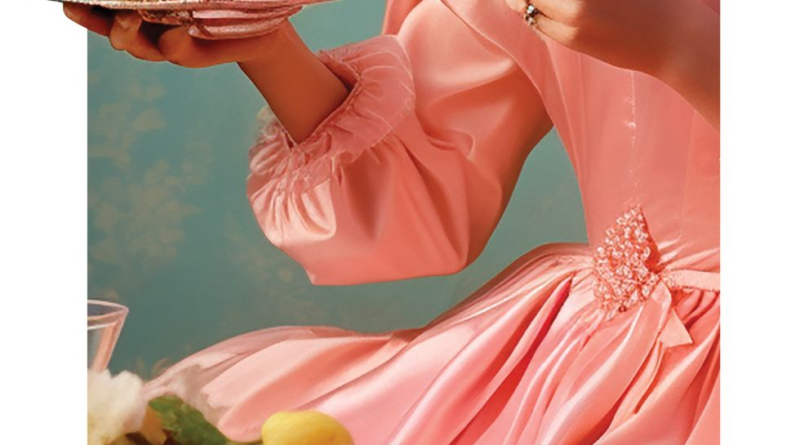My So-Called #TradWife Life
Kendel Kay looks like a lot of TikTok influencers. She’s got the icy-blonde hair, the perfectly tanned skin, the filter that makes it look like she’s not wearing makeup, just dewy and “natural.” And like a lot of influencers, she’s found her 500,000-plus following posting TikToks detailing the mundane details of her twentysomething life. The difference, as she posted in a video of her morning routine, is that she is showcasing the life of a self- professed “stay-at-home girlfriend.”
She and her boyfriend have an agreement: He’ll make the money, and she’ll “take care of the house.” And that’s what Kendel films herself doing. She makes the bed. She pops big ice cubes out of one of those silicone trays and into her Stanley cup, then fills it with filtered water. She meditates, runs the dishwasher, and makes a smoothie. She ice-rolls her face, puts on a lot of serums, then dresses in exercise clothes and does a strength workout on the balcony of her luxury apartment. The top comment on one video: “I love your life.” Kendel does all the things you’re supposed to do to look the way women are told they’re supposed to look. But unlike most women her age, Kendel does all these things and she doesn’t have to work. Or, more accurately, if there are some women who are working two, three, or even four jobs—some paid, some unpaid—Kendel is only working one. The job of very hot girlfriend to a very rich man.
You can see how alluring that might be—and why accounts like Kendel’s are so popular, even when some of the women behind them are living less of the luxury stay-at-home-girlfriend life, like Kendel, and more of the homesteading, mother-to-6-to-10-children, quoting- Bible-verses life. Many of these women, known as #tradwives, adhere to a rigid set of principles governing modesty in dress, meekness in demeanor, and a willingness to leave the number of children you have “in God’s hands.” And yet, like Kendel, they manage to make the “one job” of homemaking (while creating enough content to be an influencer!) look simple and joyful. All you have to do is be willing to wholly depend on the man in your life.
When my editor at ELLE asked me if I would be game to “try out” living like one of these influencers, I balked. First of all, I’m not married to my partner—we live together in sin—which means I could neither be a #trad nor a #wife. I have no kids (on purpose!). I also left Christianity behind a long time ago, so I don’t believe in submitting to God’s will for me. But I was game to do what I normally did over the course of the week—only I wouldn’t work for pay, and I’d take on all the labor “for the family” that I usually split with my partner.
But I needed more specifics on what this #tradwife life would actually look like. I asked my Instagram followers for their favorite tradwife accounts, and the answers poured in: a mix of the mildly satirical and not really tradwife at all (@maryorton, whose account looks like a Laura Ashley ad came to life, but who works as an investor); the bucolic (@ballerinafarm, a Juilliard-trained ballerina who married into the JetBlue family and who now lives on a farm in Utah with her seven children); and Christian twee (@call_mejewels, who, like most “real” tradmoms, adheres to the principles of biblical womanhood—and who posted a reel series this past spring called the “7 day homemaker dress challenge,” about committing to wearing a dress while doing housework).
On TikTok, there were stay-at-home girlfriends like Kendel, but there were also crunchy, natural-birth, “slow, simple living” moms like @sarah_wildmothering, and Estee Williams (@esteecwilliams), who seems to be doing some very conscious Marilyn Monroe cosplay. For Estee, being a “traditional wife” means wanting a partnership like her grandparents’—which includes not going to the gym by herself (so as not to attract unwanted advances); not leaving the house alone after dark; avoiding opposite-sex friendships; making sure her husband “does not have to lift a finger” while he’s home; cooking him “the food he wants to eat”; wearing the clothes he likes; styling her hair the way he enjoys; and asking her husband’s permission for expenses outside of those needed for day-to-day maintenance of the home.
I live on an island of just under 1,000 people, so it was easy to avoid going to the gym by myself (our “gym” is the Peloton in the basement). I could avoid leaving the house after dark (in the summer, it stays light until 9 or 10 p.m.). My partner, Charlie, and I both work from home, so did that mean I was supposed to….make him lunch? And breakfast? And also dinner? Tradwife life says: Yes. Was I supposed to put on a dress and do my hair and makeup, even if I wasn’t leaving the house? Also yes. To be a tradwife, not just a stay-at-home girlfriend, I’d also have to ditch all leggings and shorts, let him pick the nightly television viewing, do all the errands, and be responsible not just for returning all of my online orders, but all of his. I’d need to post a bunch of pictures of us together where I talk about how hot he is, but also make sure to run the caption past him ahead of time. Annoying, sure, but doable. I was also supposed to stop taking birth control and let God be in control of my womb, to which I said: No way.
I told Charlie about this plan. Maybe I expected him to be excited about all those meals? Or think it was funny? But apart from insisting that I clarify that he was not encouraging this behavior in any way, his real question was the same as mine: Was I willing to lose money to write this story? I write an email newsletter that shows up twice a week, every week; I tape a podcast that goes dark just three times a year. Whatever I made writing this story wouldn’t cover what I’d give up by insisting on taking that time off. And chances were very high I’d just end up with a bunch of simmering resentment for him, even if this was a stunt.
Because here’s the truth: Tradwife behaviors aren’t something you can try out like a new morning routine. They seem to require a wholesale ideological conviction that a woman’s primary role is to be the helpmate of her spouse. They demand a subsumption of personal will, an unquestioning eagerness to bend to a man’s desires—and a belief that those who don’t are sinning against God. When you’ve spent nearly a decade of your current relationship and the entirety of your adult life striving for financial and emotional and domestic labor–related equity in partnerships, trying to adopt this mindset doesn’t just chafe. It gives me hives.
Submission and simplicity can be most attractive during times of duress. People have historically glommed on to charismatic religions when it feels like the world is changing in ways that make it feel unfamiliar—and they crave something, anything, steady. It makes sense, too, that some of the women who become followers of religious sects that preach the gospel of biblical womanhood may be escaping some form of personal or familial trauma. To give up control can feel very much like achieving it.
But there are so many ways to find the sort of steadiness that these accounts, biblical or otherwise, seem to offer. If nonbelievers are attracted to them because they seem to promise a life where you get to stop scrambling to do it all, where there’s actually time to do things like bake a cake, or make clothing you like, or just be with your children without an agenda—that doesn’t mean you should become a #tradwife. It just means that we’ve normalized the substitution of women’s labor for a functioning social safety net, and still organize society as if every family has an adult who doesn’t work outside the home, when that’s not the reality for 80 percent of American families.
That also doesn’t mean feminism has failed us. It means that legislatures largely controlled and influenced by men—many of whom believe in some version of biblical womanhood—have worked really hard to make a life of submission this attractive, and a life of agency this hard. They’ve rolled back reproductive rights, of course, but they’ve also stood in the way of the sort of childcare reform that would make parenting easier—not just for working moms, but for all parents. They’ve busted unions and suppressed the sort of labor protections that would put boundaries on the workday. They’ve ensured we’re the only developed country in the world without mandatory paid family leave. And it’s all very purposeful, if rarely articulated.
Still, in 2021, a legislator from my home state of Idaho said the quiet part aloud while defending his choice to reject federal funding for early childhood education: “Any bill that makes it easier or more convenient for mothers to come out of the home and let others raise their child, I don’t think that’s a good direction for us to be going.”
Over decades, these men have managed to make family life harder than it should ever be for millions upon millions of Americans. And in our white-hot rage, our bone-deep exhaustion, we find ourselves doomscrolling social media—or, a decade ago, flipping through reality TV—only to find ourselves beguiled by a vision of cheerful docility. It’s a brilliant distraction, really. It allows men’s continued accumulation of power, their control over women’s bodies and futures, to go unquestioned.
As I was gearing up for my doomed-to-fail experiment, my beloved dog died unexpectedly and traumatically. Deep in grief, I did what I would have done for my #tradwife week: I stopped working, and took care of my family and my home. I walked for miles with my other dog, and spent hours crying and comforting and just talking with my partner. I gardened for hours. I made simple dinners and cleaned up after them. I didn’t have to change the way I dressed, or change my relationship with Charlie, or maintain a spotless home to be a good caregiver for my family. I just had to show up. And we found a semblance of steadiness amid those storms. I didn’t have to be a #tradwife to find it. I just had to be a good partner.
This article appears in the September 2023 issue of ELLE.
Formerly a journalist with BuzzFeed News, Anne Helen Petersen now writes Culture Study on Substack, and is the author of three books, most recently Can’t Even: How Millennials Became the Burnout Generation. She lives in Missoula, Montana.









